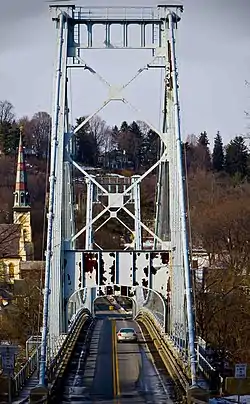Kingston–Port Ewen Suspension Bridge | |
|---|---|
 Bridge looking north into Kingston, 2007. | |
| Coordinates | 41°55′02″N 73°59′03″W / 41.91716°N 73.984165°W |
| Carries | Wurts St. (Old |
| Crosses | Rondout Creek |
| Locale | Kingston, New York |
| Official name | Kingston–Port Ewen Suspension Bridge |
| Maintained by | New York State Department of Transportation |
| ID number | 1007350 |
| Characteristics | |
| Design | Wire cable Suspension bridge |
| Total length | 2 side spans of 176.25 feet (54 m) each, anchorages, total length 1,145 ft (349 m) |
| Width | 2 lanes plus walkway, 37 feet (11 m) |
| Longest span | 705 feet (215 m) |
| Clearance below | 85 ft (26 m) |
| History | |
| Opened | 1921 |
| Closed | September 25, 2020 |
| Statistics | |
| Daily traffic | 15,700 |
| Toll | no |
| Location | |
The Kingston–Port Ewen Suspension Bridge, sometimes known as the "Rondout Creek bridge", "Old Bridge" or "Wurts Street Bridge", is a steel suspension bridge spanning Rondout Creek, near where it empties into the Hudson River. It connects the City of Kingston to the north, with the village of Port Ewen to the south. Completed in 1921, it was the final link in New York's first north-south highway on the West Shore of the Hudson, and is considered an important engineering accomplishment associated with the development of early motoring.
Construction began in 1916, with a view to replacing the Rondout Creek chain ferry named Skillypot, known for sporadic service. The Skillypot was named after a derivative of a Dutch word for tortoise, schildpad. [1] The bridge was designed by the firms of Holton D. Robinson and John A. Roebling's Sons Company,[2] with Holton D. Robinson, Daniel E. Moran, William Yates listed as chief engineers[3] Construction was hampered by local political and financial difficulties, as well as material shortages caused by entry by the United States into World War I, and was suspended until 1920.
When construction resumed, David B. Steinman was among the engineering staff, acting as Assistant Engineer. Completion took about a year, and local legend has it that the contractors employed a woman as a welder: commonplace during World War II, but unheard of in 1920. Ten thousand people attended the bridge's dedication on November 2, 1921. The bridge has a very hilly approach on the north side and crosses a small island in the creek. It forms a dramatic backdrop to the Rondout-West Strand Historic District to the east.
The bridge was closed on September 25, 2020, for a three-year reconstruction project that is estimated to cost $44.6 million.[4]
See also
References
- ↑ (National Park Service site)
- ↑ information from the Structurae page
- ↑ Information from the archived Bridgemeister site
- ↑ Pineiro-Zucker, Diane (October 15, 2021). "Rondout Creek Bridge $44.6M reconstruction project begins". Daily Freeman. Retrieved November 21, 2022.
External links
- description from National Park Service website
- ca. 1922 image from National Park Service website